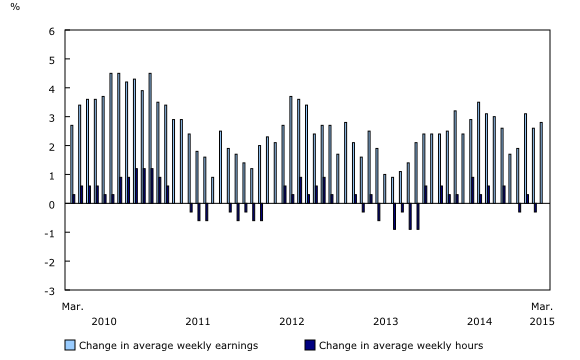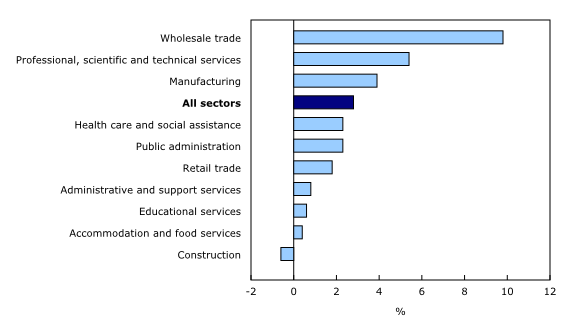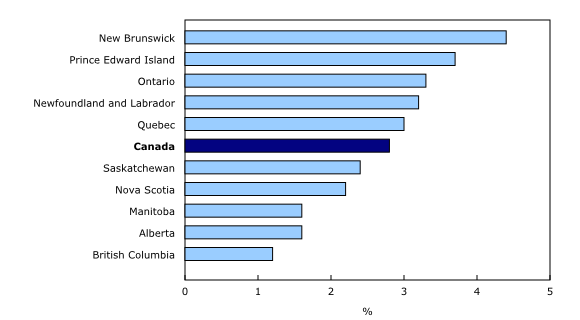Payroll employment, earnings and hours, March 2015
Archived Content
Information identified as archived is provided for reference, research or recordkeeping purposes. It is not subject to the Government of Canada Web Standards and has not been altered or updated since it was archived. Please "contact us" to request a format other than those available.
Released: 2015-05-29
Average weekly earnings of non-farm payroll employees were $954 in March, little changed from $951 the previous month. Compared with 12 months earlier, weekly earnings increased by 2.8%.
The 2.8% increase in weekly earnings compared with March 2014 reflected a number of factors, including wage growth, changes in the composition of employment by industry, occupation, and level of job experience, as well as average hours worked per week.
Non-farm payroll employees worked an average of 33.0 hours per week in March, virtually unchanged from the previous month and unchanged from a year earlier.
Average weekly earnings by sector
Year-over-year growth in average weekly earnings outpaced the national average in 3 of the 10 largest industrial sectors: wholesale trade; professional, scientific and technical services; as well as manufacturing. At the same time, earnings were little changed in administrative and support services, educational services, accommodation and food services as well as construction.
On a year-over-year basis, average weekly earnings in wholesale trade rose 9.8% to $1,188, with most of the growth occurring between September and December. In the 12 months to March, earnings growth was widespread within the sector, led by food, beverage and tobacco wholesalers as well as machinery, equipment and supplies wholesalers.
Average weekly earnings in professional, scientific and technical services increased 5.4% to $1,361 in the 12 months to March. Gains were widespread, led by architectural, engineering and related services, as well as computer systems design and related services.
On a year-over-year basis, weekly earnings in manufacturing were up 3.9% to $1,077. Earnings growth was driven by gains in transportation equipment manufacturing; non-metallic mineral product manufacturing; as well as primary metal manufacturing.
Average weekly earnings by province
Year-over-year average weekly earnings of non-farm payroll employees increased in every province in March. The highest earnings growth was in New Brunswick, while British Columbia had the lowest.
In the 12 months to March, average weekly earnings in New Brunswick increased 4.4% to $855. Earnings growth was spread across most sectors, led by gains in educational services as well as professional, scientific and technical services.
Compared with 12 months earlier, average weekly earnings in Prince Edward Island increased 3.7% to $790, with widespread gains led by finance and insurance.
In Ontario, average weekly earnings rose 3.3% to $962 on a year-over-year basis, the largest increase in earnings since January 2011. The gains in Ontario were driven by growth in wholesale trade; professional, scientific and technical services; as well as manufacturing. Earnings in the province have been increasing since November.
British Columbia had the lowest earnings growth of the provinces compared with March 2014, increasing 1.2% to $905. The low growth was partly attributable to earnings declines in health care and social assistance, as well as a drop in the number of employees in the high-earning mining, quarrying, and oil and gas extraction industry.
Non-farm payroll employment by sector
The number of non-farm payroll jobs fell by 19,500 in March, following a decline of 14,000 in February. The largest declines in March were in retail trade, manufacturing and construction. At the same time, there were more payroll jobs in accommodation and food services as well as arts, entertainment and recreation.
In the 12 months to March, non-farm payroll employment increased by 161,500 or 1.0%. Over this period, employment growth was highest in forestry, logging and support (+3.7%), real estate and rental and leasing (+3.3%); accommodation and food services (+2.9%); as well as professional, scientific and technical services (+2.8%). At the same time, employment declined in mining, quarrying, and oil and gas extraction (-4.5%), with most of the decline since October. Employment in utilities (-3.9%) was also down on a year-over-year basis.
Note to readers
The Survey of Employment, Payrolls and Hours (SEPH) is produced by a combination of a census of payroll deductions, provided by the Canada Revenue Agency, and the Business Payrolls Survey, which collects data from a sample of 15,000 establishments. The key objective of SEPH is to provide a monthly portrait of the level of earnings, and the number of jobs and hours worked by detailed industry at the national, provincial and territorial level.
Estimates of average weekly earnings and hours worked are based on a sample and are therefore subject to sampling variability. This analysis focuses on differences between estimates that are statistically significant at the 68% confidence level. Payroll employment estimates are based on a census of administrative data and are not subject to sampling variability.
Statistics Canada also produces employment estimates from its Labour Force Survey (LFS). The LFS is a monthly household survey, the main objective of which is to divide the working-age population into three mutually exclusive groups: the employed (including the self-employed), unemployed and not in the labour force. This survey is the official source for the unemployment rate and collects data on the socio-demographic characteristics of all those in the labour market.
As a result of conceptual and methodological differences, estimates of changes from SEPH and LFS do differ from time to time. However, the trends in the data are quite similar.
Unless otherwise stated, this release presents seasonally adjusted data, which facilitate comparisons by removing the effects of seasonal variations. For more information on seasonal adjustment, see Seasonally adjusted data – Frequently asked questions.
Non-farm payroll employment data are for all hourly and salaried employees, as well as the "other employees" category, which includes piece-rate and commission-only employees.
Average weekly hours data are for hourly and salaried employees only and exclude businesses that could not be classified to a North American Industry Classification System (NAICS) code.
All earnings data include overtime pay and exclude businesses that could not be classified to a NAICS code. Earnings data are based on gross taxable payroll before source deductions. Average weekly earnings are derived by dividing total weekly earnings by the number of employees.
With each release, data for the current reference month are subject to revision. Data have been revised for the previous month. Users are encouraged to request and use the most up-to-date data for each month.
A summary table is available from the Browse by key resource module of our website. Under Summary tables, choose Subject then Labour.
Data on payroll employment, earnings and hours for April will be released on June 25.
More information about the concepts and use of the Survey of Employment, Payrolls and Hours is available online in the Guide to the Survey of Employment, Payrolls and Hours (Catalogue number72-203-G), from the Browse by key resource module of our website under Publications.
Contact information
For more information, contact us (toll-free 1-800-263-1136; 514-283-8300; infostats@statcan.gc.ca).
To enquire about the concepts, methods or data quality of this release, contact Emmanuelle Bourbeau (613-951-3007; emmanuelle.bourbeau@statcan.gc.ca), Labour Statistics Division.
- Date modified:




